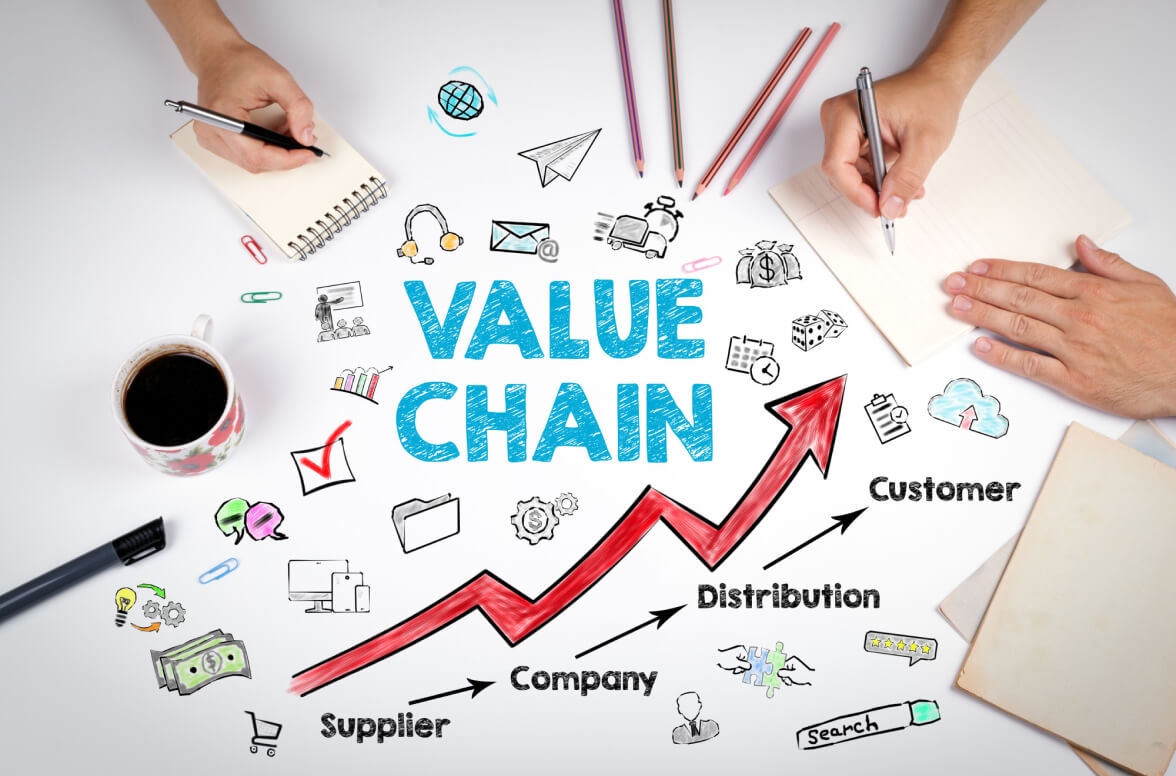18 December 2020
With more than 67 percent of world trade happening through global value chains, your current value chain needs review. Your current distribution, logistics, operations, and more require streamlined processes.
The more effective and seamless each step of the value chain, the better your product delivery. To understand these processes, you need to explore value chain analysis. Learn more about this analysis and the tools you need to make it possible for your business.
Components of a Value Chain
Several moving parts play into your value chain. Porter’s value chain model breaks down each moving part to help businesses understand and analyze their processes.
These interconnected components include two major segments split between support and primary activities. Support activities in a value chain include the following:
- Firm infrastructure: support systems and daily operations
- HR management: recruitment, hiring, training, retention
- Technology development: information management and processing
- Procurement: resource purchasing and vendor partnerships
Each of these supporting activities often has its own department heads and teams. These work alongside the following components of primary activities, including:
- Inbound and outbound logistics: receiving, storage, distribution, and product delivery
- Operations: changing inputs to outputs for customer sales
- Marketing and sales: communication and persuasion for product purchase
- Service: product value and customer satisfaction
These segments, part of any business value chain, require careful analysis using the right tools. Analyzing the primary and supporting parts of your business chain helps deliver higher-value products.
How Does Value Chain Analysis Work for Your Business?
Value chain analysis gives your business different advantages. These advantages depend on your value chain’s focus.
Choosing your focus means selecting cost or differentiation as a concentration point for analyzing your value chain. Focuses for your value chain model include:
- Cost leadership: achievable through high asset use, low production costs, and analyzing your value chain
- Product differentiation: offering specialized goods or services at a higher cost for production and delivery
These advantages allow your business to provide its goods or services at the lowest possible cost for given markets. Or, they determine integrated, streamlined processes for supporting activities in your value chain model.
Implementing these advantages begins with a value chain analysis. This analysis requires tools and action steps to help you adapt your value chain.
1. Establish Primary and Support Activities
The first step in a value chain analysis requires knowledge of which value components your business uses. Your business may not use every activity, which analysis shows. To identify which activities your business uses, consider project management software.
Using the right software, you can track cross-functional team progress and effectiveness. A good platform gives you visual tools to ease analysis. This is most important for a focus on the differentiation advantage.
2. Cost Determination for Activities
Analyzing your real cost versus perceived values improves value chain productivity. Using a prioritization matrix can help determine which activities in your value chain are actually worth more or less.
Your contribution margins can also establish which activities are worthwhile for current or altered budgets. Those activities which generate larger profit margins might be worth a bigger budget. This serves a focus on cost leadership advantages.
3. Understand Customer Perceptions
Understanding customer perceptions of your products can help determine your business focus. Your value chain may need to align with product differentiation or focus on decreasing production costs. To understand this information, you need accurate data reporting.
EasyBusiness targets customers on a global scale to give you the fullest analysis of customer perception. With over 60 different criteria to identify targets, you can locate a new strategic focus with ease.
Your value chain analysis should include quantitative and qualitative data. Using this data, you can create customer profiles for the best differentiation focus.
4. Evaluate Competitors’ Processes
You can (and should) compare your value chain to industry competitors. Internal evaluation only gets your business so far, especially if you overlook any activities that improve the value chain.
With a solid understanding of industry benchmarks, your comparison should show consistent activity structures used. External perspectives from consultants can also generate valuable insights. Using a database to compare yourself to competitors can provide the information needed, too.
5. Locate Competitive Advantage Opportunities
After researching competitors’ value chains, use the collected data to leverage advantages. Find areas to add value and undercut competitors with a cost or differentiation advantage.
Your advantage opportunities rely on your value chain’s focus. For a cost advantage, focus on:
- Growing economies of scale
- Usage pattern capacity
- Current process connections
- Furter integration possibility
- Timing for processes
This focus relies on low-cost products, both in delivery and production. If this does not fit within your value chain, explore the differentiation advantage. It emphasizes:
- Design and development
- Marketing and sales
- Customer relationship management
Locating these opportunities comes with the use of a reliable database. Kompass’s Global B2B Directory allows for better market segments. Connecting with trusted partners and suppliers gives you the upper hand in precision purchasing strategies.
Adapting Your Value Chain for the Future
After conducting a value chain analysis, you better understand what needs improvement in your product delivery. Finding the right supplier and partners makes all the difference. Reliable partners save you time and money, lending your business more credibility.
At the Kompass Group, we understand the vital nature of a strong value chain. Our global B2B directory connects you with trusted suppliers and partners. We verify and profile companies with a high standard. Our directory structure allows you to better target markets and make precise purchases.
To learn more about our worldwide network and our solutions, and find your perfect partners and suppliers, get in touch with our team today.












Comentarios
No Comments